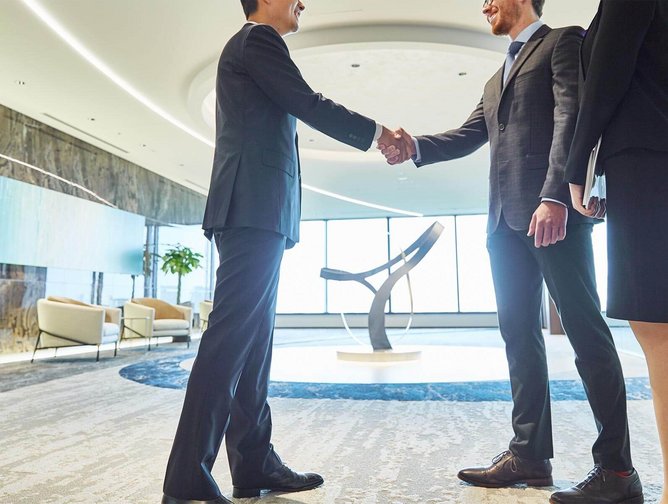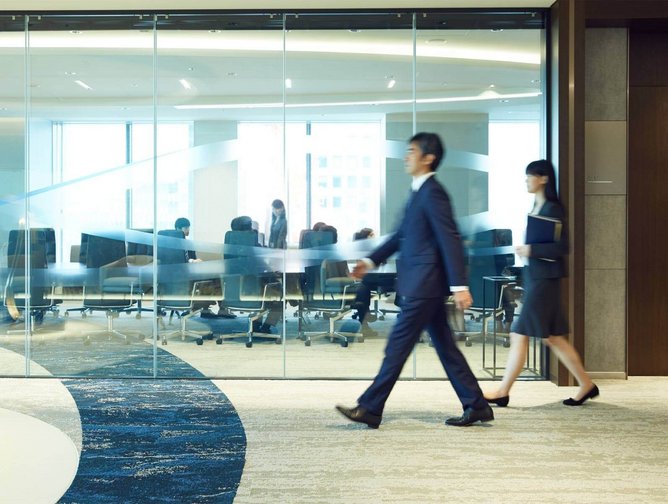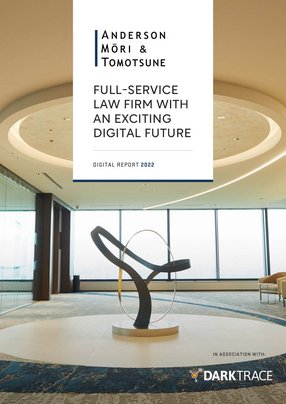AMT: Full-service law firm with an exciting digital future
It’s been a tumultuous time during the pandemic, with many industries experiencing shutdowns and massive disruptions of the supply chain. With prices rising, Anderson Mori & Tomotsune - one of Japan’s largest full-service corporate law firms - has been there to support global clients, quickly identifying the key issues and providing appropriate temporary solutions throughout the state of emergency. This process included assessing the value of solutions and developing new ways to stay competitive in the new business and economic environment. Additionally, the firm underwent its own inward-focused transformation, restructuring to handle some of the rapidly emerging, extraordinary demands that occurred during the pandemic.
2022 marks the 70-year anniversary of the firm. It is continuously striving to provide services that best meet the needs of clients by utilising accumulated experience and knowledge, as well as through strong relationships with the top, trusted law firms around the world.
Handling new legal challenges in an uncertain world
Yoshihide Hojo is Chief Security Officer, Legal & IT Tech Strategy at Anderson Mōri & Tomotsune. Having been with the firm for 7 years, Hojo explained how the pandemic caused the largest decline in international flows the company had ever seen, putting it under the pressure of rapid anti-globalisation.
“Businesses experienced the shutdowns, the massive disruption of supply chains, and now we are experiencing the rising input prices.
“As a full-service corporate law firm supporting global clients in international and cross-border projects, AMT had to quickly identify the key issues, support and promptly provide appropriate, far-sighted advice for each phase where clients were responding emergencies, seeking temporary solutions to meet new demands, re-assessing their value and developing new strategies to stay competitive in the new business and economic environment.
"While tackling our own rapid change and transformation, we needed to sort information and form our structure to support our clients facing new legal issues. We needed to be inward-focused and also client-centric at the same time,” said Hojo.
Turning to technology and a new digital strategy
AMT had to respond to the emergency, scaling up initiatives of the digital strategy it used to map in one- to three-year phases in a matter of weeks.
“In a very short period of time, we rolled out online communication tools firm-wide, online marketing tools to keep our digital channels, other tools to improve process efficiency and to escalate digital operations within our firm,” said Hojo.
And to accommodate the rapidly increased volume of remote work, AMT also doubled and tripled the capacity and capability of the VPN (virtual private network) and VDI (virtual desktop infrastructure).
Hojo added: “We also adopted the SASE (Secure Access Service Edge) solution to optimise our global network for such workload changes.
"As rapid changes in operations and system environments can introduce new risks, we also needed to strengthen our cybersecurity capabilities - such as monitoring, analysing, resilience - and expand cybersecurity measures to protect the new components added as we widely adopted work-from-home.”
Hojo explained that when it comes to innovation, AMT must think of the ultimate benefit to their clients, focusing on what they actually want.
“As we often see the client in a stressful or time sensitive situation, we start the process of innovation by asking: how can we deliver the best possible experience to our clients by leveraging our strengths through our legal services?”
He explains that they start with the big picture and then focus on more specific processes.
“We analyse and visualise specific processes by using business process modelling, etc. Then, with the keywords such as problem solving, logical thinking, agility, collaboration, technology adoption, we develop a solution that leads to the end-to-end client experience.
"Since innovation cannot be successful with technology adoption alone, we also place great importance on the consideration of the elements of people and culture in our innovation efforts. Such as the preferred approaches and tools in a particular industry, client, or legal area.
"For example, we have been providing solutions to automate and streamline processes by using automation tools, such as a solution that semi-automates the generation of a set of documents required for a specific process, such as a company registration, etc.
"By providing and utilising these technology solutions, we are able to speed up complicated and time-consuming tasks, and our lawyers can spend their time on the areas that lead to better quality of our services and greater client satisfaction. I believe that these efforts provide new value and satisfaction to our clients, leading to AMT's continued growth in this uncertain time.”
Starting with the big picture view with legal practices and firm operation
Hojo speaks of innovation efforts, but he believes the firm is at a tipping point and needs to look at the longer-term impact of technological change on the business.
“In the legal sector, the culture of law itself has been a major barrier to successful technology adoption, since law was built with rules and regulations. These barriers made it difficult for technologists to understand what the firm exactly needed and how to integrate solutions in the best way."
AMT has been working as an interdisciplinary team of lawyers, paralegals, KMs and technologists, to look into the detail of each legal task and seek opportunities for technology adoption to improve the speed, efficiency of the process, and accuracy of the outcome.
“Working as an interdisciplinary team enabled us to include cultural factors into those processes as well. Although we are just getting started on our challenges and have a long way to go, based on what we've seen so far, I think these approaches and initiatives are driving increased client satisfaction and firm business opportunities,” said Hojo.
AMT has been working and experimenting with AI and ML for different tasks such as document review and translation. But, as the pandemic became a catalyst for innovation, people moved toward digitalisation and AI, resulting in explosive data growth.
“Under these circumstances, the use of AI and unstructured data analysis was inevitably promoted, expanding beyond e-Discovery to areas such as cybersecurity and compliance and beyond,” said Hojo.
“We just started building our foundation for innovation. We’ve learned a lot in the steps we’ve taken. We continue to explore the possibilities of emerging technologies,” he added.
In terms of evaluating and implementing solutions to automate and enhance processes, AMT uses their interdisciplinary team, selecting the participants who are familiar and have expertise with the relevant process to form a team.
“We develop a good list of evaluation criteria and take the necessary time to conduct the trial. Evaluations focus on the functional aspects and also cost-effectiveness and user experience from the solution.
"And the most important phase is the post-deployment. And we emphasise ongoing efforts to integrate the solution into business processes, measure the effectiveness, learn and educate how to sustainably utilise them in our business operations, and encourage the use of technology,” said Hojo.
Improving services as a client-centric business
AMT has many ongoing and upcoming projects, including ones for document management, document search and review, knowledge management and data analytics, a collaboration platform, information governance and the ever-changing realm of cybersecurity.
“The goal of these projects is not only to introduce new tools and services, but also to create new value through their integration. So we are working to achieve this goal in stages with ideas from different teams,” said Hojo.
Putting the customer first is already at the centre of the firm’s strategy.
“By learning how technologies and data can create new efficiencies and values, provide insights, manage risks, and create the future of law, and by collaborating with each team, we believe that they will lead to a highly customised experience for our clients,” said Hojo.
Digital Experience (DX) has also helped AMT to re-shape their cybersecurity, as Hojo explains: “Every change in the business environment involves some risks. Successful digital and business transformation requires a cybersecurity strategy that is optimised for them.
It is critical to understand both DX and cybersecurity, and find a way to develop actionable strategies that complement each other. AMT has been working to develop such strategies and plans since pre-pandemic time.
Putting DX and cybersecurity together as a strategy, and redesigning and rebuilding cybersecurity measures that perfectly covered the complexity of the new hybrid business environment wasn’t easy for Hojo.
“We are still in the middle of our digital and business transformation journey, and halfway through a cybersecurity re-shaping. I‘m truly grateful to our talented teams at AMT and our valued technology partners for making sure we are getting where we need to be,” he said.






